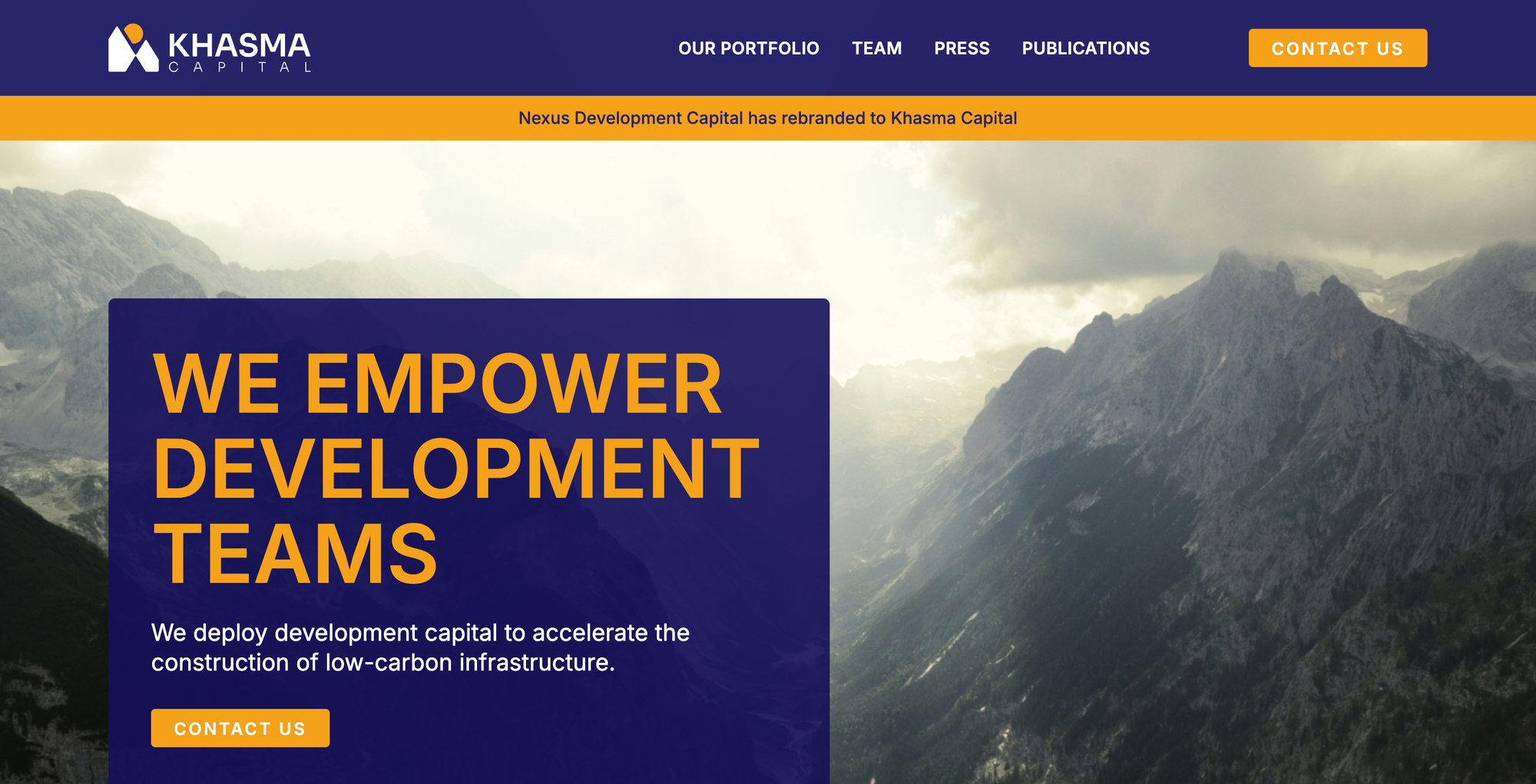In the latest episode of the Investing in Impact podcast, I sit down with Josh Kaufman, CEO and Co-Founder of Khasma Capital, to explore how his team is rewriting the rulebook for early-stage climate infrastructure investing.
Formerly known as Nexus Development Capital, Khasma Capital has rebranded with a renewed mission: to empower development teams building the next generation of low-carbon infrastructure.
As the climate crisis intensifies and the demand for scalable solutions grows, Khasma is stepping into a crucial space—funding and accelerating the infrastructure that most investors deem “too early” or “too complex.”
Causeartist BackOffice
Your Mission-Aligned Operations Team
From investor-ready financials to growth strategy, HR, compliance, and custom software—Causeartist BackOffice is your all-in-one operational partner. Built for impact startups, funds, and nonprofits, and powered by our experts.
Let us handle the back office—so you can stay focused on impacting the world.
The Challenge: Bridging the Infrastructure Capital Gap
Climate technology is booming. From carbon capture and renewable fuels to waste-to-energy and geothermal, entrepreneurs are innovating rapidly. But there's a persistent gap—moving from pilot or demonstration projects to fully scaled infrastructure deployments.
This "valley of death" is especially pronounced in hard-to-abate sectors and capital-intensive industries. Traditional institutional investors often won’t touch these projects until they’re fully de-risked. Meanwhile, venture capital is more focused on software, platforms, or IP—not the physical, operational build-out.
That’s where Khasma Capital comes in.
“We saw incredible innovation happening, but many of these developers simply couldn’t get the capital or operational support they needed to reach commercial scale,” Josh shared during the episode. “So we designed Khasma to meet that exact need.”
A Hybrid Model: Capital + Strategic Support
Khasma isn’t just writing checks. Their model is hybrid by design—combining flexible, early-stage development capital with deep operational and strategic support.
Josh and his team bring decades of experience as investors and operators in the climate and infrastructure sectors.
That experience allows them to work shoulder-to-shoulder with founders, helping them validate their business model, navigate regulatory complexity, hire strategically, and prepare for commercial scaling.
“We often act as a true partner to development teams,” Josh explains. “That means getting into the weeds—not just as investors, but as advisors, supporters, and connectors.”
Sectors of Focus: Circularity Meets Emerging Energy
Khasma is laser-focused on high-impact, undercapitalized sectors that are vital to climate transition but often overlooked by traditional funding sources. These include:
- Circular Economy Solutions like textile recycling, cement alternatives, waste upcycling, and mineral recovery.
- Emerging Energy Transition Technologies such as long-duration energy storage, industrial heating decarbonization, renewable heating oil, and clean marine fuels.
Each portfolio company reflects a strategic thesis: these aren’t just technologies—they’re scalable infrastructure systems with long-term climate, social, and economic value.
For example, Khasma is backing projects that:
- Convert industrial waste oil into clean marine fuel
- Recycle solar panels to extract valuable commodity materials
- Build North America’s first fleet of zero-emission maritime vessels
- Produce high-energy gases through innovative oxy-fuel systems
These are not MVPs. These are mission-critical facilities, fleets, and supply chains.

What Khasma Looks for in a Partner
Khasma’s investment criteria are grounded in four pillars:
- Business Model – A clear pathway to profitability and strong unit economics.
- Technology Maturity – Demonstrated progress beyond major engineering hurdles.
- Commercial Readiness – Defined projects and development workstreams.
- Team Strength – A capable founding team, with willingness to collaborate and grow.
Josh emphasized that Khasma also helps augment teams, whether by filling knowledge gaps or bringing in additional leadership as needed.
“Great climate infrastructure doesn’t get built by capital alone. It takes exceptional people, strategic alignment, and deep operational insight.”
Looking Ahead: The Next Decade of Climate Infrastructure
As the episode wraps, Josh shares his vision for what the next 10 years could look like: a surge in climate infrastructure that is distributed, resilient, and regenerative—driven by bold developers and backed by aligned capital.
He believes Khasma’s role is to be an enabler—to help developers cross the chasm from idea to infrastructure. And in doing so, Khasma isn’t just investing in projects—they’re investing in a more sustainable future.
Subscribe on Apple Podcasts
Subscribe on Spotify
Q&A Podcast Transcript
What first pulled you into climate and energy?
Josh: In college I realized every time I saw a renewable energy article I went down a rabbit hole. I joined GE because about a third of global electricity uses some GE equipment, which felt like the best vantage point to learn power markets. After analyst training at GE Capital I moved into GE Power M&A, buying and selling assets across countries and technologies.
Later I joined QIC, an Australian infrastructure fund, and saw a gap. Wind and solar fit infra mandates, everything else looked too small or too risky. I wanted to invest earlier, de-risk projects, and sell them to infra funds. That became the vision for Kazma.
Your tagline is “we empower development teams.” Why those words?
Josh: Our customers are developers, not necessarily tech companies. Think real estate development as the analogy. They do not invent turbines, they assemble sites, permits, EPC, offtake, and financing. Traditional VC is too early stage for this work, and real asset investors are too late.
Developers still need millions to get from concept to shovel ready. We are not trying to take control. We set negative control rights to protect capital, support the plan, then step back once the project is shovel ready. The goal is to back the right people, not to run their projects.
How do you typically structure an investment?
Josh: We are often the first institutional check after friends and family. We refresh governing docs, take a board seat, and set approval rights for material moves like major financings or key contracts. We do not direct the day to day. They own the strategy, we help them execute and meet phase gates.
What stage is the right time to come to Kazma?
Josh: Late early to mid development. We need project definition. Not just a thesis like “storage in Texas is big.” We want enough detail to diligence cost to build, likely offtake structure, permitting path and timeline, interconnection or feedstock risk, and whether the end state can be project financed.
Where do you invest geographically?
Josh: The United States and Canada.
Give us a couple of live examples from the portfolio.
Josh:
• One Planet, solar panel recycling, Florida. Storm damage and construction breakage send a lot of panels to landfills, which clashes with installers’ values and emerging state rules. We are scaling a facility that extracts more silver, copper, and silicon. Our role is to validate feedstock supply, confirm product pricing, and ready a larger, roughly nine figure, project for infrastructure financing.
• Castle Rock, renewable heating oil from woody biomass in the Northeast. Through pyrolysis we produce a lower grade oil that can replace fuel oil in boilers at schools and hospitals where gas pipelines are limited. The process is simpler than producing finished road fuels, which helps the early economics. We funded development and expect first project financing to follow.
What did your learning curve look like moving across so many technologies?
Josh: Deep and hands on. You stack domains over time, gas, solar, wood, biochar, biofuels. None of it is impossible, there is just a lot of it. You have to be close to real projects to learn well.
Big picture, how has renewable energy changed since 2009?
Josh: Costs for solar and storage are down dramatically. There are more smart people and more capital. The bottleneck is interconnection and transmission. Gigawatts wait in queues run by utilities and regulators, which slows the pure electrify everything, decarbonize power path.
That friction is what pushes attention to options like hydrogen and carbon capture.
Who actually holds the keys on interconnection and transmission reform?
Josh: Regional operators, utilities, and regulators, not investors. The work is wonky and opaque. Shining a light on how RTOs and ISOs change rules would help everyone.
How healthy is solar right now, residential and commercial?
Josh: We do not invest in solar directly, but growth has been strong and tech is bankable. The question is keeping growth high in the face of interconnection delays and business model pressure.
You saw a large residential player like Sunnova enter bankruptcy, which shows the stress in parts of the value chain even as deployment rises.
How does Kazma make money on these projects?
Josh: We take development risk for one to two years with no revenue, then seek two outcomes. First, we get paid at shovel ready to reflect the risk we took when few others would. Second, we retain equity so we participate in value once projects are built and cash flowing. We think you need both to build a durable business.
How do incentives and subsidies figure into underwriting?
Josh: There is always a green premium or incentive somewhere. We assess how material it is and how durable it is.
For example, our biofuel project benefits from the Renewable Fuel Standard. It has lived through multiple administrations and was just updated, which gives us more confidence. We try not to build a stack that depends on several fragile programs at once.
What is your read on carbon credits and other eco-credit revenues?
Josh: It depends on dependence. We like credits as a minority revenue stream, for example biochar credits layered on top of a solid core business. We are cautious when a plan is almost fully dependent on voluntary credits.
The market is still thin, with a few buyers like Microsoft playing outsized roles. If a single buyer changes course, a project should not collapse.
From the allocator seat, what challenges come up repeatedly?
Josh: The work is hard, which is why there is white space. The way through is discipline on recurring risks. Verify that technology produces the promised spec at the required rates and conditions. Follow proper phase gates, do not build before design is finished. Underwrite teams, not just ideas. Many failures repeat the same process errors. Our team is heavy on project developers and engineers for that reason.
What outcomes are you aiming for over the next three to five years?
Josh: Break ground on more first-of-kind projects. We already broke ground on an organics to renewable natural gas digester outside Chicago. We want our Maine biofuel project in construction, and further progress on our clean burning natural gas with carbon capture pathway. These create local, high quality jobs and improve energy resilience, which resonates across the political spectrum.
How do you frame impact for stakeholders who do not lead with climate?
Josh: Energy resilience and domestic industry. For example, oxygen-fired natural gas with carbon capture produces a concentrated CO₂ stream that is easier to sequester. If you can do that, you get reliable, cleaner power while using domestic resources. That is a common goal, regardless of political stance.









